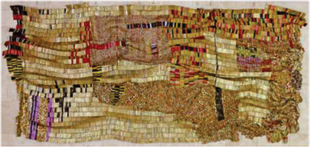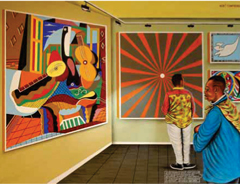“Art and AIDS have been inextricably linked throughout the epidemic’s quarter of a century history. Art has conveyed what words alone cannot.” UNAIDS Executive Director, Peter Piot.
World AIDS day 2007 marked the first anniversary of the UNAIDS’ Art for AIDS collection—an art collection created to recognize the role art has played in the response to AIDS. From AIDS quilts in America to memory books in Africa, from painting, multi-media to sculpture—AIDS has influenced art and the artistic world.
The pieces in the collection have been chosen to provoke thought and dialogue around some of the most difficult issues around AIDS. With an initial emphasis on contemporary African art, the collection has grown to more than 60 museum quality pieces thanks to the involvement of artists, collectors and donors around the world.
In this, the first of a special three-part series, www.unaids.org tells the story of the collection and its creators.
The collection
 Ghanaian artist El Anatsui, uses pieces of found meal such as
Ghanaian artist El Anatsui, uses pieces of found meal such as
bottle caps that he twisted and strung together to create a
commentary on AIDS and the AIDS response.Among the pieces in the UNAIDS permanent collection is ‘Crust of the Earth’ a mixed media metals sculpture by Ghanaian artist El Anatsui. Drawing from his environment, El Anatsui uses pieces of found meal such as bottle caps that he twisted and strung together to create a commentary on AIDS and the AIDS response. One of India’s best known artists, Maqbool Fida Hussain, created ‘Mother Theresa’ a painting for the permanent collection. This oil on canvas depicts a mother and child shown together—symbolizing the hope that exists in the response to AIDS.
“I’m so please we are able to share works by leading artists in the world. These are artists whose pieces have graced the walls of the Tate Modern in London, the Guggenheim in Bilbao, and the Pompidou in Paris.” said Annemarie Hou, UNAIDS Chief of Communications and Knowledge Sharing and curator of the UNAIDS collection.
 With names such as ‘Courage’,
With names such as ‘Courage’,
‘Compassion’ and ‘Community of
Love’, Fisher—who is openly living
with HIV— expresses her feelings on
AIDS.Throughout the lobby of the building are seven towering sculptures generously donated to the UNAIDS permanent collection by UNAIDS Special Representative, artist and author Mary Fisher. With names such as ‘Courage’, ‘Compassion’ and ‘Community of Love’, Fisher—who is openly living with HIV— expresses her feelings on AIDS and the response. And outside the UNAIDS building, stands the statue ‘Eradication’ by Zimbabwean artists Mike Munyaradzi. To the artist, the statue symbolizes “the fragile world we live in today”. The hollowed sphere signifies the destruction of our globe and the difficult issues of our time, including AIDS. The leaf represents hope and the life we are struggling to sustain.
The permanent collection also includes a number of stunning photographs by Gideon Mendell and Jonathan Torgovnik. Torgovnik recently won the UK National Portrait Gallery's Portrait Photographic Prize for his work to give a voice to the women that were raped during the genocide, had a child and contracted HIV.
In addition to the permanent collection, UNAIDS has been fortunate to be granted the loan of a number of other museum quality pieces.
 In addition to the permanent collection, UNAIDS
In addition to the permanent collection, UNAIDS
has been fortunate to be granted the loan of a
number of other museum quality pieces.“We are very fortunate to have art on loan from the Jean Pigozzi Geneva collection,” said Ms Hou. “ Pigozzi’s collection, one of the most important in the world, includes works of artists that live and work in sub-Saharan Africa who use different formats of expression ranging from paintings and sculptures to video and multi-media,” she added.
Also exhibited are pieces loaned by the ‘ArtAids’ organization, founded by Dutch writer and art collector Han Nefkens, who set up the organization to “use art to increase involvement with AIDS issues so that real contributions can be made towards creating a better existence for people living with HIV. The proceeds of the sale of works commissioned by ArtAids will provide people living with HIV with medical care to which they would otherwise not have access.
Arte carte - browse online
Accompanying the art collection, UNAIDS has also produced the ‘Art for AIDS art carte’ which catalogues the collection pieces in words and pictures. This art carte is available in hard copy and is now available to browse online, through the new e-book feature.
“The collection and the accompanying arte carte, are designed to enable as many people as possible to enjoy and benefit from this inspiring work. Several pieces have provoked hallway conversations and heated discussions—to hear people talk about the art was when we knew the collection was working,” Annemarie Hou said.
Q&Amp;A with curator Annemarie Hou
Q: How do you decide what goes into the collection?
A: It’s creative and collaborative process that focuses on the connection between Art and AIDS. We decided to begin the collection with a focus on contemporary African art, and one of the first artists we thought of was El Anatsui. He is known for his amazing sculptures. Crust of the Earth was our first partnership and I consider this commentary on AIDS the anchor of our permanent collection.
Other times we work with collectors such as Jean Pigozzi. He advises us and shares with us the same paintings that are hanging in museums. In fact one of the paintings by Cheri Samba that was on our wall is now at the Tate Modern in London.
Q: How does UNAIDS acquire art?
A: We have three main ways we acquire art – donations, loans and commissions. Most pieces are on loan or have been donated either by the artist or a sponsor. The installation Redouté by Leo Copers is on loan from collector Hans Nefkens and the art is for sale. If someone buys the work (25,000 Euros) the proceeds will help fund AIDS treatment.
We have also commissioned three pieces. The first, from Maqbool Fida Hussain, was donated by the artist. The piece by African artist El Anatsui UNAIDS was in part a gift of the artist and UNAIDS paid an honorarium. And the third example, a sculpture by Mike Munyaradzi entitled Eradication, was made possible by a gift from Johnson & Johnson. It was incredible to see the piece installed—it required a crane and the artist working together to put this in place.
Q: This sounds like a lot of work…
A: It is an investment in time, attention and resources. Because art pieces can be fragile much of our efforts go into making sure that shipping and installation go smoothly. We do quarterly inspections of the artwork and representatives of the loaned collection also regularly check on the pieces.
This first year we had some additional start up costs, for the donated and loaned pieces we paid for to ship and install 60+pieces—about $51,000. Now our yearly costs should go down to about $20,000.
As none of us are art professionals we are lucky to have excellent advisors sharing their knowledge with us. It’s also been a lot of volunteer hours but I think I can speak for my colleagues when I say we do it because we love art and think it is an incredible resource for inspiration. And for anyone interested we would love an Art for AIDS sponsor!
Q: I heard that one of the photographs in the collection was life changing for the photographer?
A: It is a photograph of Margaret. It’s part of a collection of photographs from Jonathan Torgovnik a photographer for Newsweek magazine. Jonathan was in Rwanda on assignment covering UNAIDS for a story on the 25 years of AIDS.
I joined him and then journalist Geoffrey Cowley one day to listen to testimony of a genocide survivor, a woman who was raped and became pregnant and contracted HIV. Margaret told us her story with a soft voice, taking us hour by hour, day by day through her life. Jonathan was so moved he has been back to ensure that more of these stories are told and not forgotten and he as started a foundation education for the children. Now that is inspiring!
An interview with Jonathan Torgovnik will be featured as part three of the series, on Friday 7 December.
Links:
Read feature story - Contemporary African art and AIDS Read feature story - Secretary General visits UNAIDS, Geneva
Three-part series on Art for AIDS:
Part 1: Art for AIDS: A sculptor’s voice
Part 2: Art as an inspiration
Part 3: More than words: ART for AIDS





